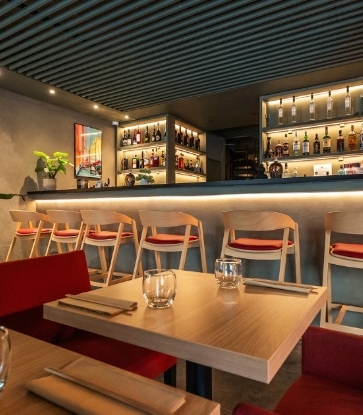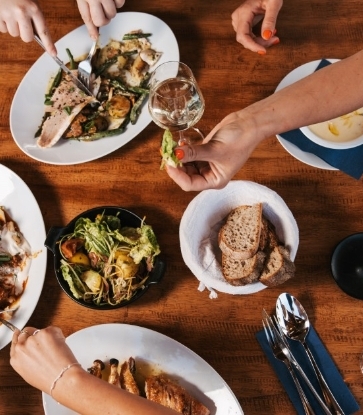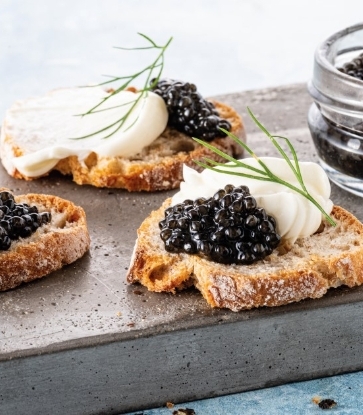Paprika – made from dried and ground pepper and chilli plants – is synonymous with Hungarian cuisine. It forms the basis of many of the country’s dishes including soups, sauces, casseroles and stews, and is a key ingredient in traditional Hungarian fare such as goulash and paprikash. But there isn’t one single type of paprika; there are in fact eight distinct grades, ranging from mild to pungent, spicy and even sweet. Each variety imparts a distinct colour, flavour and fragrance when added to dishes, as we discovered from some of Hungary’s top chefs.

The Backbone of Hungarian Cuisine
“Paprika is a spice powder made from drying and grinding the pods of different types of peppers,” explains Dániel Katona, Executive Chef at Budapest’s FELIX Kitchen & Bar, located on the banks of the Danube. “It’s an essential ingredient in Hungarian cuisine and it gives many dishes their brilliant, orange-red colour and intense, peppery flavour and aroma. Paprika can be sweet, hot and even smoked – and it comes in different grades of coarseness and colour.”
At FELIX, paprika is used in two key dishes, one being venison goulash (gulyás), a type of soup comprising venison, paprika, onions, potatoes and vegetables such as carrot and celery. Here, the team uses édesnemes paprika, also known as ‘noble sweet’. It’s bright red, with a slight pungency. FELIX’s other speciality is catfish paprikash. This also uses édesnemes and consists of catfish cooked in a creamy paprika and crème fraîche sauce, served with cottage cheese, durum wheat pasta, fresh dill and dill oil. “Paprika is the backbone of Hungarian cuisine” adds Dániel, “and paprikash has been the Hungarian national dish for two centuries”.

Variety Is the Spice of Life
“The use of paprika as a spice significantly transformed Hungarian cuisine,” agrees Ádám Barna, chef-owner of Esztergom-based restaurant, 42. “When we use paprika, it’s often very prominent and determines the taste and character of the dish.” Ádám and the team use paprika sourced from Hungary’s Bács-Kiskun county, in southern Hungary, where these thirsty plants thrive on the nutrient-rich soil close to the Danube.
At 42, paprika is used in a variety of dishes, ranging from savoury to sweet. To kick things off, paprika is introduced in the form of an amuse-bouche, alongside sour cream. “Then, for our lecsó (a Hungarian version of ratatouille), we use several types of peppers prepared with different methods to give a more layered, complex flavour. We use Hungarian wax pepper, capia pepper and hot green peppers. We also employ three different ways of preparation: we roast them in their skins in the oven; fry them in duck fat in an iron pan and mince them raw for the sauce,” says Ádám.
With so many varieties of paprika available, how does the team determine its quality? “Good quality paprika tends to be ruby-red in colour, with a roasted and slightly caramelised aroma and a nice fruitiness,” explains Ádám. “The paprika will be fine to the touch and, depending on the processing method, may have a floury texture.”
Ádám and the team carefully choose the best paprika – and cooking technique – for each dish. “The best paprika for making lecsó is the Hungarian wax pepper, while for goulash and fish soup, we use ground paprika. For barbecuing, one of the best types of paprika is the capia pepper – because of its high sugar content, it caramelises nicely when grilled. For pickling, the late summer tomato peppers have a very nice, sweet flavour. A sharp, green pepper also goes well with csabai sausage and sourdough bread.”
At 42, this versatility also extends to sweeter items on the menu. “We even use paprika in our chocolate truffles!" says Ádám. "The roasted paprika adds body as well as a depth of flavour.”

Layers of Flavour
To really understand paprika and its influence on Hungarian cuisine, it’s important to be familiar with some of the key varieties. “Édesnemes (noble sweet) is the most commonly used paprika in Hungarian cooking,” explains chef-owner Dávid Pallag from Rutin in Budaörs. “It has a rich, sweet flavour and is bright red in colour. Csemege paprika is slightly milder but still adds a sweet and fruity taste to dishes. Csípősmentes csemege (delicate) offers the same fruity flavour as csemege but without the heat, while csípős (hot) paprika has a moderate level of spiciness and is often used to add a gentle kick to dishes.
“Rozsdás (rusty) is deep-red in colour and has a more pronounced, smoky flavour while erős (strong) is significantly hotter than csípős, and its intense spiciness is favoured by those who enjoy fiery flavours. Félédes (semi-sweet) offers a balance between sweet and spicy flavours, making it a versatile option in Hungarian cooking, while rózsa (rose) has a distinctive aroma and a milder taste, and is commonly used as a finishing touch in dishes.”
At Rutin, different types of paprika are used depending on the dish being prepared. “The édesnemes and csemege varieties are often used in soups, stews and meat dishes to provide a sweet and flavourful base, while we incorporate the csípős and erős paprika in spicier dishes, such as goulash or paprikash, to add a fiery kick,” David says.

Homegrown Produce
“Paprika is so characteristic of Hungarian cuisine that people from other countries often typify Hungarian dishes with its excessive use,” says Ádám Mede, Executive Chef at Laurel in Budapest. But that’s not the case for Laurel, where paprika is the key ingredient in one dish in particular.
“We use paprika as the foundational spice for our signature dish, catfish paprikash (harcsapaprikás),” explains Ádám. “Its distinctive flavor is achieved by combining several types of Hungarian paprika, including csemege (mild), csípős csemege (spicy mild), and a mixed paprika blend.
“Additionally, we incorporate hot smoked paprika. While smoked paprika is not traditionally common in Hungarian cuisine, its smokiness pairs exceptionally well with our harcsapaprikás dish, and the smoky flavour naturally infuses into the dish as we cook it in a cauldron (bogrács). Upon special request, our supplier creates a unique hot smoked paprika for us, which uses hawthorn wood instead of the more common acacia or beechwood for smoking. This creates a more pleasant aroma with a fruitier flavour profile but without the bitter aftertaste, and it complements our catfish stew perfectly.”
Like the team at 42, Laurel uses Fajszi Paprika as their suppliers. “We’ve used Fajszi Paprika from the beginning. They are a family-run farm in Fajsz. The proximity of the Danube River ensures that their growing area has fertile soil and a favourable microclimate, creating excellent quality paprika.”

Perfect Pairings
“The presence of paprika reminds me of the flavours of home and the way we cooked when I was a child,” reminisces chef Endre Kollár of Budapest’s St. Andrea. “For me, working in the fine dining sector, our task is to show the playfulness that Hungarian paprika can bring to a dish. Due to its smokiness, lively colour and the surprising fresh or even spicy taste of some varieties, paprika is a wonderful ingredient that’s deeply rooted in the traditions of Hungarian gastronomy.”
At St. Andrea, paprika is used primarily in the preparation of their game dishes. “On our winter menu, you’ll find wild stew with mushrooms, blueberries and homemade tarragon. Paprika brings unmistakable colour and depth to this dish. We also like to work with Szeged (sweet) paprika, because it brings a beautiful deep-red colour around our venison, reminiscent of the colours of the autumn forest.”
Endre and his team at St. Andrea use a number of varieties of paprika including ground paprika, hot pepper, cherry and capsicum. “We also work with paprika oil, which is made by cold-pressing the seeds of hot peppers. It really enhances the flavour of dishes,” says Endre.
“We also have an internationally-recognised winery, and we’ve found dishes that contain paprika go well with St. Andrea's popular Bikavér-type wines. The fruity finish of, for example, the Szeged paprika works in beautiful harmony with the deep, saturated, fruity flavour of the red wines. It’s this harmony of flavours that’s key for us when planning our menus.”

















